Charger Xtar VP2
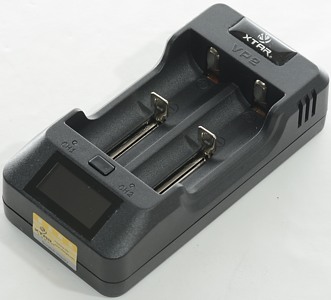
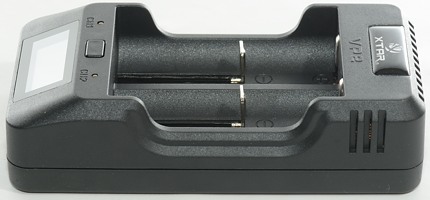

Xtar has many good LiIon chargers, this is an upgrade to their most advanced charger the VP1. It has two channels, each with a voltmeter, 3 current settings and 3 voltage settings. It can also be used as a usb power box.


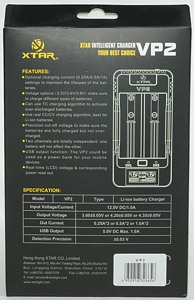

It comes in a cardboard box with a window.
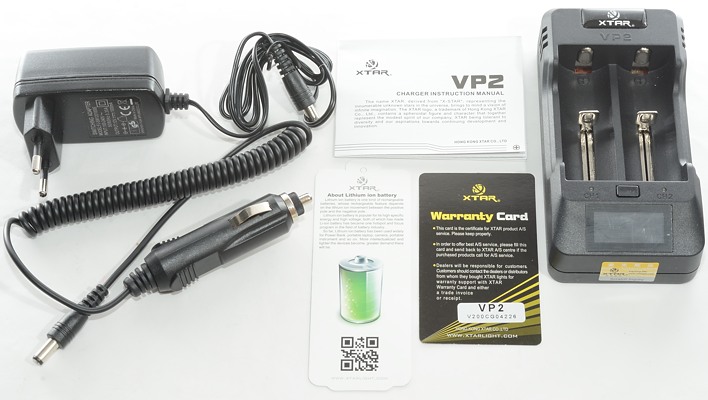
In the box is the charger, a power supply, a car adapter, a instruction sheet, a warranty card and a sheet about LiIon batteries.
The sheet about LiIon list the advantage with using LiIon batteries and has a table with the 3 different types that this charger can handle.

The charger has a DC connector for power input, a usb output and a voltage switch. The actual position of the voltage switch is shown on the display of the charger, when no batteries are in the charger, I believe this is a very good idea.
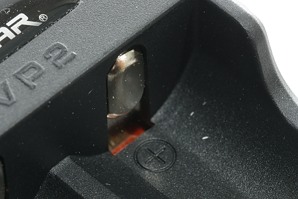
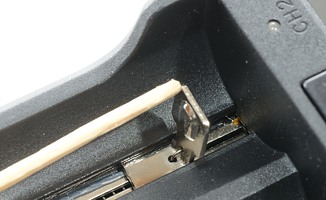
The slots have raised battery connections, i.e. flat top batteries can be used. The slider works very smooth and can take batteries from 30mm to 71.2mm.
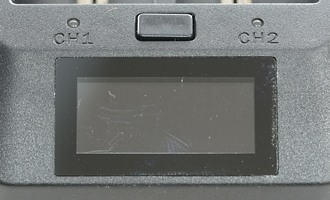
On the top of the charger is a switch to select charge current, it can select between 0.25A, 0.50A and 1.00A, the current will be the same in both slots. There is also two leds to show when the batteries are full. The leds are red when charging and green at other times. When usb output is activated the one for the usb battery is used to show the battery charge state.
Below the switch is the display, by holding the switch down the display can be turned off/on (but not the leds), this will not affect any function in the charger.

Here is the display captured during startup, where all elements can be seen.
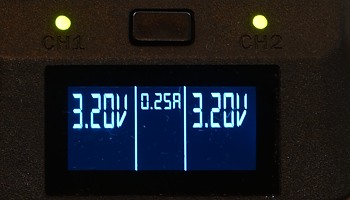
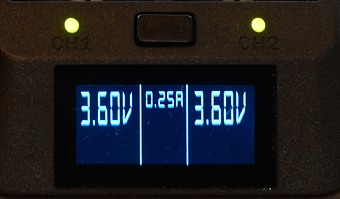
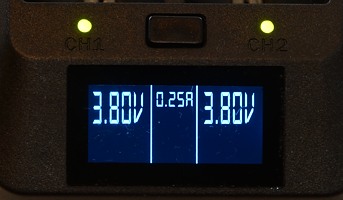
When there is no battery in the charger, the display will show the selected charge voltage, this will also be shown if the switch is changed during charge. The selected current will be shown between the two voltage displays.
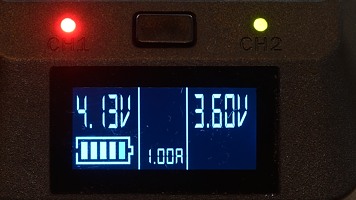
During charge the display will show the actual battery voltage and the battery icon is animated.
The user interface is a good upgrade from VP1 with the charge leds and the white background lightning is shield much better on this charger.
The voltmeter has a good precision, when charging it will show slightly above the battery voltage, as expected. Sadly it will not really work above max. charge voltage: it will show one value and then stop updating.
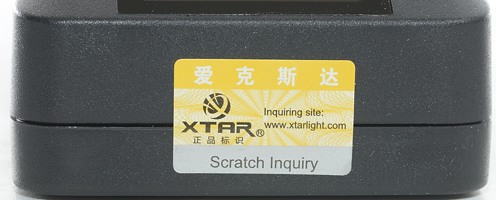
Xtar has recently started adding a product verification code to their equipment. This code can be verified on their website.


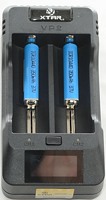
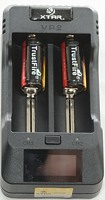

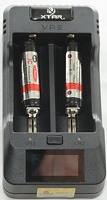

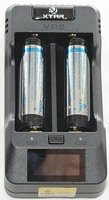
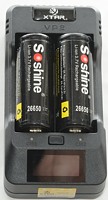
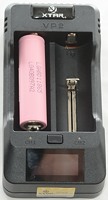
The charger can handle 70 mm long batteries, inclusive flat top cells.
Measurements
- Changing the voltage selector will restart charging.
- Below 2.0 volt the charge current is 1.5 mA.
- Between 0.15 volt and 2.0 volt the battery symbol will flash and voltage will be updated, but it need 1 volt to start this mode (Led is red).
- Between 2.0 and 2.9 volt the charger current is about 50mA/50mA/80mA in the 3 current ranges (Led is red).
- Above 2.9 volt the regular CC/CV is used, see curve below.
- Without power it will discharge the battery with about 12mA on usb channel and 5mA on the other channel.
- With power it will charge with about 0.3 mA when the battery is full.
- Build in voltmeter is within +/-0.01 volt when not charging.
- Build in voltmeter about +0.01 volt at 0.25A
- Build in voltmeter about +0.02 volt at 1.00A
- The voltmeter can show voltages from 0.01 volt to above 4.35 volt, but will freeze the reading, when it is above selected charge voltage and not resume updating, before voltage is below again.
- When selecting charge voltage without a battery in the charge the voltmeter shows selected voltage.
- Charge will restart if battery voltage drops to 3.9 volt (3.3 in LiFePO4 mode).
- The charger will restart when a battery is inserted or power is cycled.
- Because each channel is independent, the different voltages varies between the channels with a small amount.
%20%231.png)
First charge curve shows a very nice CC/CV curve with a termination about 70mA. This is a very good charge curve.
%20%232.png)
The other channel does also work fine.
%20%231.png)
%20%231.png)
Different capacity batteries, need different charge time.
%20%231.png)
Reducing the charge current to 0.5A, does reduce the termination current slightly and it uses the same good CC/CV curve.
%20%231.png)
The 0.25A charge current uses same termination as 0.5A, this time the termination current is on the high side.
%20%231.png)
Trying to provoke the charger with my old 16340 cell does not show any problems, the charger handles it nicely.
%20%231.png)
Reducing the charge current to the 16340, makes the curve more smooth.
%20%231.png)
A 14500 cell at 0.5A works fine.
%20%231.png)
Same with a 18350 at 0.5A.
.png)
There is not much difference between charging one and two cells at the same time.
.png)
Using an external 12V supply, the charger draws nearly 1A while charging.
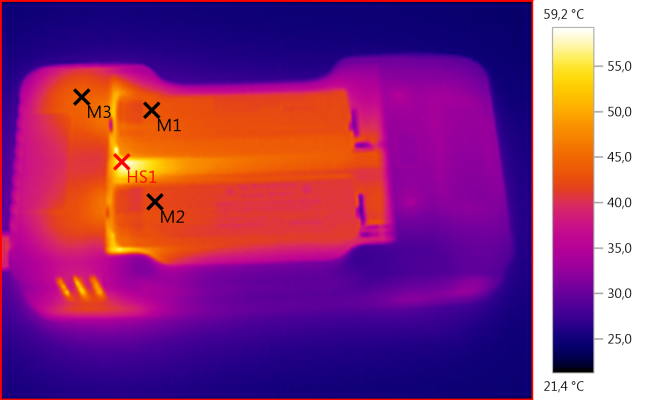
M1: 43,4°C, M2: 42,1°C, M3: 44,3°C, HS1: 59,2°C
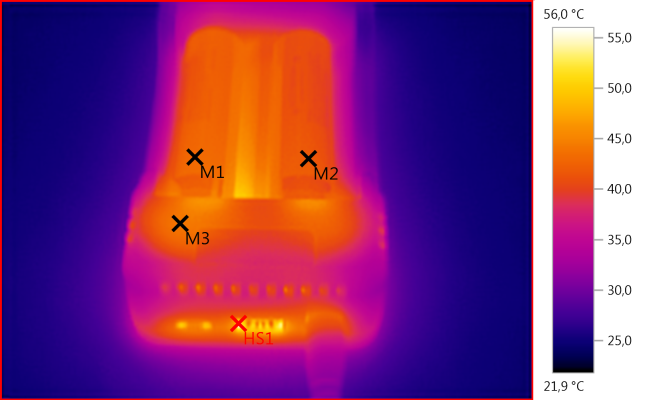
M1: 43,2°C, M2: 41,8°C, M3: 44,2°C, HS1: 56,0°C
There is no surprise in the temperature profile: The electronic generates some heat, this makes the usb connector hot and increases the temperature of the batteries.
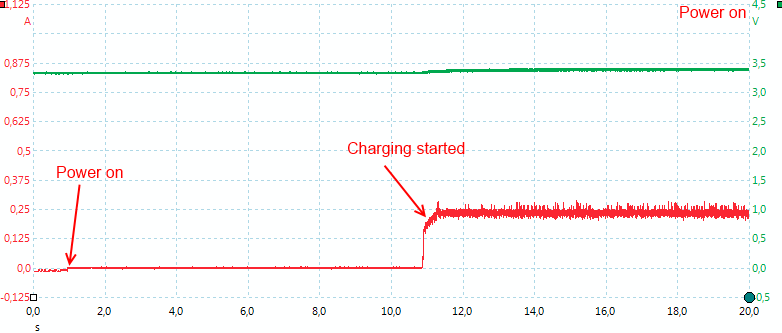
The charger needs about 10 seconds to turn on and will always turn on at the 0.25A setting.

When selecting a higher current, the charger will slowly increase the charge current, until the new setting is reached.
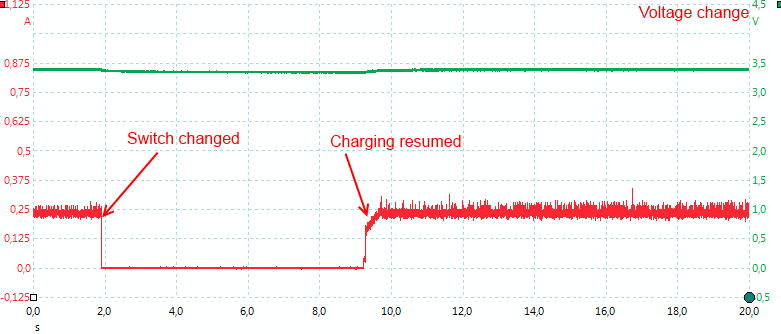
A chemistry change stops the charger and restarts it a bit later.
3.0 and 3.2 volt batteries (LiFePO4)
Some LiIon are marked 3.0 volt, they are usual 3.2 volt LiFePO4 batteries and must be charge with a 3.6 volt charger. The VP2 has a setting for this.
%20%231.png)
Again the charge does a nice CC/CV and turns off when the battery is full.
%20%231.png)
I did start with the cell fully discharged and the charger starts reviewing the cell, first going to full current when the voltage reach 2.9 volt.
It does not adjust that setting when changing battery voltage. The actual charge curve is fine.
4.35 volt charging (Switch at 3.8 volt)
A few LiIon batteries can be charged with a higher voltage than the usual 4.2 volt, either 4.30 volt or 4.35 volt. This charger supports the 4.35 volt type, the 4.30 volt type must be charged with 4.20 volt or can be charged with the 4.35 volt if the voltage of the charger is slightly low (This MUST be verified on the charger first).
%20%231.png)
The 4.35V charging does also look perfect.
USB output
- Does not turn output off automatic when unloaded, this requires a button press.
- Usb output is coded as Apple 1A
- Display is off when using usb output.
- The green led is on above 3.5 volt battery voltage.
- The red led is on above 3.15 volt battery voltage.
- Below 3.15 volt the red led is flashing.
- When a lower voltage led indication has been activated, the battery must be removed to reset it.
- Usb will discharge the battery with 24mA when nothing is connected, but it is turned on.
- Only one slot is used for usb output power.
- Usb output can only be used when the charger is without 12 volt power.
- The usb output has a fairly high current drain, also when off. I.e. do not store batteries in the charger (It can drain a battery in about 10 days).
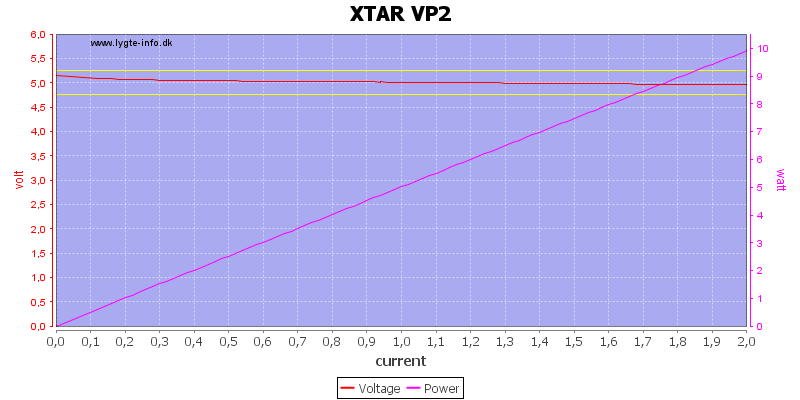
The usb output is very stable, even at 2A load, I would have preferred that there was a overload cutout.
.png)
The usb output has no problems with a 1A load, the efficiency is about 90% and it turns off the output when the battery is down to 3 volt. This looks very good.
.png)
Same with 0.5A load (I let the recording run for a few hours after the output turned off).
.png)
.png)
Other battery capacities changes the time the output is on, but the function is still good.

There is very little noise in the output, 8mV rms and 60mVpp with a 1A load.

Reducing the load to 0.5A, does also reduce the noise to 6mV rms and 50mVpp.
Testing the mains transformer with 2500 volt and 5000 volt between mains and low volt side, did not show any safety problems.
Conclusion
This charger can be used for nearly all LiIon batteries on the market and will charge them correctly. The usb output delivers very clean power, but it lacks a overload cutout.
This charger is a nice update to the VP1 charger and like the VP1 I will call it a very good charger.
Is there a reason to upgrade from the VP1? The actual charging is the same, but VP2 support more chemistries, larger batteries and it has a very visible led, showing when it is finished with charging. If you are using or going to use any of these batteries that it now support, an upgrade might be a good idea.
Could I wish for more in this charger? The answer is yes, there are a few minor details I would have liked: 0.1A setting (Some small lights use very small LiIon batteries) and 4.30 volt charging.
Notes
The charger was supplied by Xtar for review.
Here is an explanation on how I did the above charge curves: How do I test a charger




























%20%231.png)
%20%232.png)
%20%231.png)
%20%231.png)
%20%231.png)
%20%231.png)
%20%231.png)
%20%231.png)
%20%231.png)
%20%231.png)
.png)
.png)





%20%231.png)
%20%231.png)
%20%231.png)

.png)
.png)
.png)
.png)

